人教版七年级英语unit4where's my schoolbag全英文说课课件
人教版新七年级英语暑假讲义第17讲Unit4Whereismyschoolbag(学生版+解析)

第17讲Unit 4 Where is my schoolbag【学习目标】话题房间里的物品(Things around the house)基础语音1.掌握以下辅音音素的发音:/p/和/b/、//和/d/、/k/和/g/、/s/和/z/、/0/和/o/、/m/、/n/和/p/、/w/、/j/2.掌握where引导的特殊疑问句和yes/no问句及其答句的语调必备单词名词:table桌子bed床bookcase书架;书柜sofa沙发chair椅子desk书桌room房间hat帽子head 头radio收音机;无线电广播clock时钟tape磁带;录音带;录像带player播放机model模型plane 飞机动词:come来;来到think认为;想;思考know知道;了解代词:their他(她、它)们的our我们的形容词:tidy整洁的;井井有条的副词:where在哪里;到哪里everywhere处处;到处;各个地方always总是介词:on在……上under在……下连词:but但是感叹词:yeah是的;对常用短语1.on the sofa在沙发上(pl9) 6.on your head在你头上(p20)2.in your schoolbag在你的书包里(p19)7.under the table在桌子下(p21)3.under your bed在你床下(p19)8.tape player磁带播放机(p22)e on快点儿(p20)9.model plane飞机模型(p22)5.in your grandparents' room在你(外)祖父母的房间里(p20) 10.in the bookcase在书柜里(p23)重点句型1.询问物品的位置:-Where's my pencil box?-It's in your schoolbag.(pl9)2.确认物品的位置:-Are the keys on the sofa?-No,they aren't.They're on the table.(p20)3.表明自己的主观想法或看法:I think it's in your grandparents' room.(p20)4.描述物品的位置:(1)My keys are in my schoolbag.(p23)(2)Gina's books are everywhere on her bed,on the sofa and under the chair.(p23)单元语法1.where引导的特殊疑问句(Where's the map?)2,方位介词on、in与under的用法(on the sofa,in the bookcase,under the chair)【基础知识】1、Where are my books'?我的书在哪里?(教材第19页Ia) 考频:★★★本句是由where引导的特殊疑问句。
七年级英语上册人教版Unit 4 Where’s my schoolbag?全英文教案
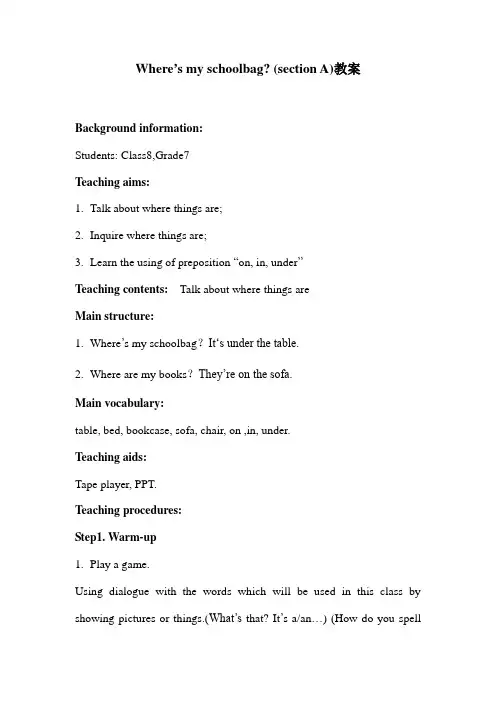
Where’s my schoolbag? (section A)教案Background information:Students: Class8,Grade7Teaching aims:1.Talk about where things are;2.Inquire where things are;3.Learn the using of preposition “on, in, under”Teaching contents: Talk about where things areMain structure:1.Where’s my schoolbag?It‘s under the table.2.Where are my books?They’re on the sofa.Main vocabulary:table, bed, bookcase, sofa, chair, on ,in, under.Teaching aids:Tape player, PPT.Teaching procedures:Step1. Warm-up1.Play a game.Using dialogue with the words which will be used in this class by showing pictures or things.(What’s that? It’s a/an…) (How do you spellit? ……)Step2. Presentation1.Let’s learnlearn the preposition of “in on under”.(Using cartoon pictures to help students understand these three words.)2.Let’s chant3.Pair workShow two things’ positions to teach target language (sentence).---- Where’s/Where’re …?---- It’s/They’re on/in/under the ….Look at the pictures and do the pair work.4.Activity 1aMatch the words with the pictures.Step3. Practice1.Do the exercises2.Do some listening practicesStep4.ConsolidetationPlay a game (Memory challenge).Step5. Homework1.Copy and recite the new words.2.Make a conversation to describe your room.Blackboard design:Where is-----? Where are-----?It’s on/in/under-----. They’re on/in/under-----.Lesson plan for Unit4 Where’s my schoolbag?(Section A, period 1)Teaching aims:1. Language goalsKey vocabulary: table, bed, bookcase, sofa, chair, where, on, under. Target language: Where’s my schoolbag? It’s under the table.Where are my books? They’re on the sofa2. Ability goalsTalk about where things are.Train the students’ communicative competence.3. Moral goalsKeep your room and tidy.Teaching important points:1. New words.2. How to talk about where things are.Teaching difficult points:1. Prepositions of place: in, on, under.2. Prepositional phrases: on the sofa, under the bed, etc.Teaching method:TBLTeaching procedures:Step1 Warming UpRevise some school things by asking questions: T: what is this? ----S: It is a/an…T: What are these? ----- S: They areStep2 Learn the new wordsShow the picture of my bedroom on the screen.Teach the new words: chair, table, bed ,bookcase, sofa.Read the words over and over again until the students can name each item fluently.Best eyes (read the words as quickly as they can)Pretend to look for my schoolbag here and there.T: I can’t find my schoolbag? Where is it? Do you know?Show the schoolbag in/on/under the chair.Let students perform as what teacher said.Step3 Practice(1) Present the key sentence patterns by using box, ball and erasers.(e.g., Where’s the ball? It’s in / on/ under the box.Where are the erasers? They’re in/on/under the box.)(2) Practice the key sentence patterns by pictures. (Q & A)(3) Pair work: choose some volunteer students to act out their own conversations.(4) Guessing game: guide the students to say out the positions of the things by using the sentence patterns.Step 4 SummarySummarize what students have learnt in this lesson.Step 5 Homework(1) Keep your room tidy and clean.(2) Use “in” “on” “under” to describe your bedroom.Blackboard design:总堂课,课堂气氛很活跃,学生积极发言,课堂效果不错。
人教版七年级上册unit4英语说课稿
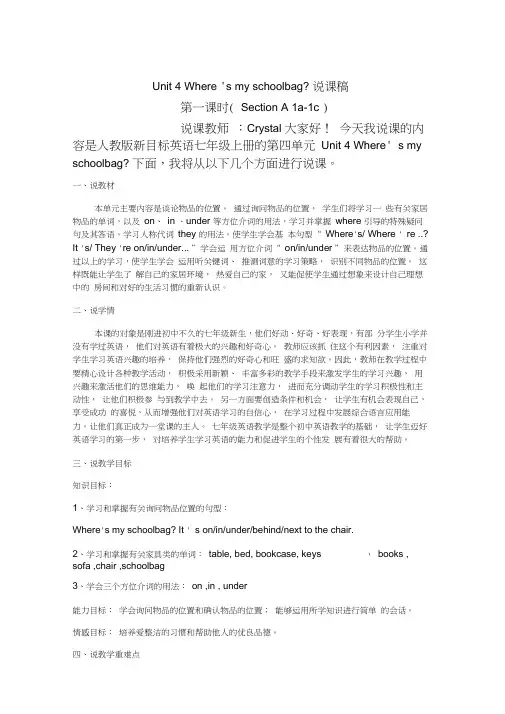
Unit 4 Where 's my schoolbag? 说课稿第一课时( Section A 1a-1c )说课教师:Crystal 大家好!今天我说课的内容是人教版新目标英语七年级上册的第四单元Unit 4 Where' s my schoolbag? 下面,我将从以下几个方面进行说课。
一、说教材本单元主要内容是谈论物品的位置。
通过询问物品的位置,学生们将学习一些有关家居物品的单词,以及on、in 、under 等方位介词的用法,学习并掌握where 引导的特殊疑问句及其答语。
学习人称代词they 的用法。
使学生学会基本句型“ Where's/ Where ' re ..? It 's/ They 're on/in/under... ”学会运用方位介词“ on/in/under ”来表达物品的位置。
通过以上的学习,使学生学会运用听关键词、推测词意的学习策略,识别不同物品的位置。
这样既能让学生了解自己的家居环境,热爱自己的家,又能促使学生通过想象来设计自己理想中的房间和对好的生活习惯的重新认识。
二、说学情本课的对象是刚进初中不久的七年级新生,他们好动、好奇、好表现,有部分学生小学并没有学过英语,他们对英语有着极大的兴趣和好奇心。
教师应该抓住这个有利因素,注重对学生学习英语兴趣的培养,保持他们强烈的好奇心和旺盛的求知欲。
因此,教师在教学过程中要精心设计各种教学活动,积极采用新颖、丰富多彩的教学手段来激发学生的学习兴趣,用兴趣来激活他们的思维能力,唤起他们的学习注意力,进而充分调动学生的学习积极性和主动性,让他们积极参与到教学中去。
另一方面要创造条件和机会,让学生有机会表现自己,享受成功的喜悦,从而增强他们对英语学习的自信心,在学习过程中发展综合语言应用能力。
让他们真正成为一堂课的主人。
七年级英语教学是整个初中英语教学的基础,让学生迈好英语学习的第一步,对培养学生学习英语的能力和促进学生的个性发展有着很大的帮助。
人教七年级英语上册Unit 4 Where's my schoolbag第一课时Section A(1a-2d)教案
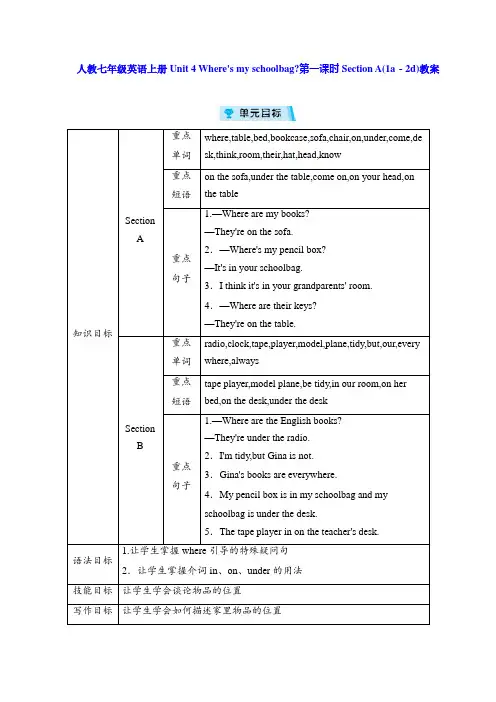
人教七年级英语上册Unit 4 Where's my schoolbag?第一课时Section A(1a-2d)教案知识目标SectionA重点单词where,table,bed,bookcase,sofa,chair,on,under,come,desk,think,room,their,hat,head,know重点短语on the sofa,under the table,come on,on your head,onthe table重点句子1.—Where are my books?—They're on the sofa.2.—Where's my pencil box?—It's in your schoolbag.3.I think it's in your grandparents' room.4.—Where are their keys?—They're on the table.SectionB重点单词radio,clock,tape,player,model,plane,tidy,but,our,everywhere,always重点短语tape player,model plane,be tidy,in our room,on herbed,on the desk,under the desk重点句子1.—Where are the English books?—They're under the radio.2.I'm tidy,but Gina is not.3.Gina's books are everywhere.4.My pencil box is in my schoolbag and myschoolbag is under the desk.5.The tape player in on the teacher's desk.语法目标1.让学生掌握where引导的特殊疑问句2.让学生掌握介词in、on、under的用法技能目标让学生学会谈论物品的位置写作目标让学生学会如何描述家里物品的位置情感目标促使学生了解自己的家居环境,热爱自己的家,使学生养成干净、整洁、合理摆放物品的好习惯第一课时Section A(1a-2d)重点单词where ad v. 在哪里;到哪里table n. 桌子bed n. 床bookcase n. 书架;书柜sofa n. 沙发chair n. 椅子on prep. 在……上under prep. 在……下come v. 来;来到desk n. 书桌think v. 认为;想;思考room n. 房间their pron. 他(她、它)们的hat n. 帽子head n. 头重点短语on the sofa在沙发上under the table在桌子底下come on 快点儿on your head在你的头上重点句子1.—Where are my books? 我的书在哪里?—They're on the sofa. 它们在沙发上。
七年级英语上册 Unit 4 Where’s my schoolbag说课稿 (新版)人教新目标版-
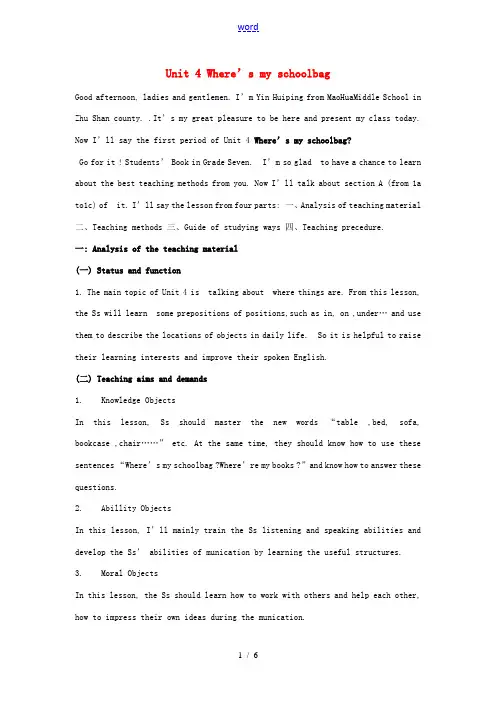
Unit 4 Where’s my schoolbagGood afternoon, ladies and gentlemen. I’m Yin Huiping from MaoHuaMiddle School in Zhu Shan county. .It’s my great pleasure to be here and present my class today. Now I’ll say the first period of Unit 4 Where’s my schoolbag?Go for it ! Students’Book in Grade Seven. I’m so glad to have a chance to learn about the best teaching methods from you. Now I’ll talk about section A (from 1a to1c) of it. I’ll say the lesson from four parts: 一、Analysis of teaching material 二、Teaching methods 三、Guide of studying ways 四、Teaching precedure.一: Analysis of the teaching material(一) Status and function1. The main topic of Unit 4 is talking about where things are. From this lesson, the Ss will learn some prepositions of positions,such as in, on ,under… and use them to describe the locations of objects in daily life. So it is helpful to raise their learning interests and improve their spoken English.(二) Teaching aims and demands1. Knowledge ObjectsIn this lesson, Ss should master the new words “table ,bed, sofa, bookcase ,chair……” etc. At the same time, they should know how to use these sentences “Where’s my schoolbag ?Where’re my books ?”and know how to answer these questions.2. Abillity ObjectsIn this lesson, I’ll mainly train t he Ss listening and speaking abilities and develop the Ss’ abilities of munication by learning the useful structures.3. Moral ObjectsIn this lesson, the Ss should learn how to work with others and help each other, how to impress their own ideas during the munication.4.Teaching keys and difficultiesAccording to the teaching aims, I think the focus of this lesson is the use of new expressions“in,, on , under… ” and help the Ss to municate with each other. The difficulty is to master the Where questions.二、Teaching methodsAs we all know: the main instructional aims of learning English in middle school is to bring upstudents’basic abilities of listening、speaking、reading and writing and their good sense of the English language. So In this lesson, I’ll mainl y use the “task-based” teaching method, and it will be used in the whole lesson. That is to say, I will let the Ss learn in real situations, finish tasks and some activities , guessing games, watching a flash, acting to help the Ss to get a better understanding of the key structure of the conversation .I think it’s helpful to develop the Ss’ thought. I’llalso use “situation municating” method. It can provide enough listening and speaking situations for Ss. I think good teaching methods are the keys to success.三、Guide of studying methodIn order to guide the Ss better, develop the Ss’ abilities, in this lesson, I ‘m not a teacher, but a guider .I’m ready to give them help whenever they need and re-correct the mistakes while talking .Each unit in Go for it contains pair work, group work and games. The students who sit at the same table and groups can make a discussion and learn from each other. It makes each student relaxed. They needn’t worry about making mistakes. It can arouse students to think and to say what they want to say. Study bees more relaxing and pleasing in this kind of environment.Then the Ss will learn how to be a good language learner , and how to municate with others. It will be very helpful for their learning in the future. I think good studying ways can help the Ss to be good language learners.四、Teaching procedure:Step One: Warming up.1. Enjoy “Where’s thumbkin’’ song.In order to form a better Englishsurrounding for Ss, attract the Ss’ attention, I’ll begin my class with an Englishsong—Where is thumbkin ? song. It can help the students to be clear. I think a goodbeginning is a half of success.2. Revise some school things..Play a guessing game by putting some schoolthings in a box to revise them. e.g.: What’s this in Eng lish? How do you spellit? Is this your…?What color is it?3.Say like this:1) Pen-pens pencil-pencils ruler-rulersKey-keys eraser-erasers book-books …2) This is a pen. These are pens.Step Two :Presentation: New words learning.1. 1.Point at a desk and say “ This is a desk.Then teach them to read “ desk,a desk , This is a desk.2. Show the pictures on the screen. Show the pictures first, then the wordsone by one. Read the new words one by one. 1).Show the picture ofa table ,ask: Is it a desk ? Help the Ss answer: No .,it isn’t.It’s a table. Writetable on the blackboard ,teach them to read table ,a table ,It’s a table .Teach‘chair ,sofa ,bookcase ,bed like this. .2). Look at the picture on page 19.Ask them to do 1a of the students’book . Match the words with the things in the picture, and check the answer together.Read the new words on the left by the students.Step Three: Presentation.1. Use real objects to present in, on, under , then show the pictures of differentpositions. Show the pictures of a box and an apple to teach ″in, on, under″2. look at the picture on the screen to present the target language again. .3.Ask some of them to do part 1of the exercise on the blackboard and check the answer together .Finally read .4..Playing a game .Listen and do. Put the book in your desk. Put the pen on your book….Step Four. Practice.1.Guide them to say sentences together according to the pictures of using in,on ,under .2.Add where question . Present ″where’s…?It’s in/on/under…″ with a penciland a book3. Show some pencils andbooks to the students and present ″Where are…? They’re….”4. Ask and answer in pairs.Encourage them to use different words and find out the best group.This activity can not only help the Ss grasp the usage of target language, but alsocan help the Ss learn from each other. It can not only improve the Ss’ speakingand listening skills, but aslo improve their ability of working with others. TheSs at this age enjoy showing themselves, so it can also improve theirstudying interests, I think it’s most important during studying, because interest is a best teacher.Step FiveListening1.Ask students to look at the pictures in activity 1a. Then ask students to readthe sample conversations in activity 1c.2 Listen to the tape, finish 1b with the students.while the Ss listening , I’ll go around the classroom and help the Ss who have troublein listening . It can not only help the Ss who have trouble in listening, but also help the teachers go closer to the Ss. I think the closer the teachers go to the Ss , the better the students will learn.亲其师,信其道。
人教版英语七年级上册Unit4Where’smyschoolbag(sectionA1a1c)说课稿
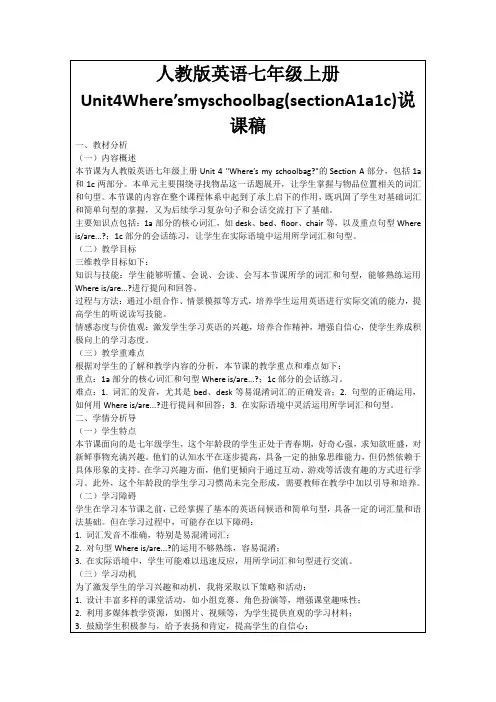
3.课后作业:布置写作任务,要求学生用所学句型编写一段寻找物品的对话。
(四)总结反馈
在总结反馈阶段,我将采取以下方式引导学生自我评价,并提供有效的反馈和建议:
1.学生自评:让学生回顾本节课所学内容,对自己的学习效果进行评价。
3.家长签字:要求家长参与监督学生的作业完成情况,签字确认。
作业的目的是巩固课堂所学知识,提高学生的语言运用能力,并培养学生的自主学习习惯。同时,通过家长签字,增强家校合作,共同关注学生的学习进步。
五、板书设计与教学反思
(一)板书设计
我的板书设计将采用清晰的布局和简洁的风格。板书分为三个部分:左上方列出本节课的核心词汇,中间部分展示主要的句型结构,右下方则用于记录学生在互动中的亮点和错误示例。板书的风格将以简洁、明了为主,使用不同颜色的粉笔突出重点,同时配以简单的图形或箭头指示句子结构和逻辑关系。
过程与方法:通过小组合作、情景模拟等方式,培养学生运用英语进行实际交流的能力,提高学生的听说读写技能。
情感态度与价值观:激发学生学习英语的兴趣,培养合作精神,增强自信心,使学生养成积极向上的学习态度。
(三)教学重难点
根据对学生的了解和教学内容的分析,本节课的教学重点和难点如下:
重点:1a部分的核心词汇和句型Where is/are...?;1c部分的会话练习。
1.对于发音和记忆困难的学生,提供额外的辅导和练习。
2.通过设置有趣的互动环节和及时的正面反馈,激发学生的参与热情。
3.精确控制课堂节奏,确保每个环节都有充足的时间进行。
课后,我将通过以下方式评估教学效果:
1.收集学生的课堂练习和课后作业,评估他们对词汇和句型的掌握程度。
Unit4Where’smyschoolbag课件-2021-2022学年人教版七年级英语上册
A.Yes,it is
B.No,it isn’t
C.Yes,they aren’t
D.No,they aren’t
( D )4.—______? —It’s in my schoolbag.
A.What’s that
A.think
B.spell
C.know
D.lose
( C )2.(2020楚雄期末) —Where is the library? —Sorry,I ______.
A.not know B.am not know C.don’t know D.not to know ( D )3.(2020禄丰期末)—Are the keys on the table? —______.
— They’re on the sofa.它们在沙发上。
23.— Are the keys on the sofa?钥匙在沙发上吗?
—No, they aren’t .They’re on the table.不,没在。它们在餐桌上。
课堂探究
1.介词 in,on,under的用法 in,on,under都是方位介词,后面跟名词或代词构成介词短语,表示 所处的位置不同,常用来表示“某物在某地”。 (1)on 意为“在……上面”,用来指两个物体相互接触。 ·There is a big clock on the wall.墙上有个大时钟。 (2)in 意为“在……里面”,常用来指某人或某物在某范围里。 ·Those two sisters are in our class.那两姐妹在我们班里。 (3)under 意为“在……下面”,常用来指一物体在另一物体的正下 方,两物体不接触。 ·There is a dog under the tree.树下有一条狗。
遵义专版七年级人教版英语教学课件Unit 4 Where’s my schoolbag
看图填空
This is my room. It’s very nice(漂亮). The
pictures are _o_n_ the wall. The computer is _o_n_ the desk. The baseball is u__n_d_e_rthe chair. My _b_o_o_k_s are in the bookcase. W___h_e_r_e_a__r_emy
1. table __b__ 2. bed _e___ 3. bookcase _h__ 4. sofa _g__
5. chair _d__ 6.schoolbag _a__ 7. books __f _ 8. keys __c__
1b Listen and number the things in the picture[1-4].
Picture 2
Picture (图片)1
(找不同)
Picture 2
In Picture 1, the baseball is behind the sofa. In Picture 2 , it’s … In Picture 1, the CDs are on the table. In Picture 2, they’re …
Yes, they are.
Be + 主语 +介词短语?询问某物或某人在某 处吗? Be动词的变化随主语的单复数而变化。 当某人或某物是单数时, be动词用is; 回答为Yes, it is. No, it isn’t. 当某人或某物是复数时, be动词用are; 回答为Yes, they are. No, they aren’t.
Revision
It’s on the table.
七年级英语人教版上册Unit4Where’smyschoolbag说课稿
三、教学方法与手段
(一)教学策略
我将采用任务型教学法作为主要教学方法。任务型教学法以学生为中心,强调学生在真实情境中通过完成任务来习得语言。这种方法的理论依据是交际语言教学法,它认为语言学习的目的是为了交际,通过有意义的交流活动,学生能够在实践中掌握语言知识和技能。
(二)教学目标
本节课的三维教学目标如下:
1.知识与技能:
(1)掌握本节课的词汇和短语,并能灵活运用。
(2)学会使用一般现在时描述物品的位置。
(3)能够运用功能句进行寻找物品的情景对话。
2.过程与方法:
(1)通过小组合作、讨论等方式,培养学生的合作意识和口语表达能力。
(2)通过任务型教学法,引导学生自主探究、总结语法规则。
4.小组竞赛:开展小组间的竞赛活动,激发学生的学习积极性,培养团队合作精神。
四、教学过程设计
(一)导入新课
为了快速吸引学生的注意力和兴趣,我将以一个猜谜游戏作为新课的导入。我会提前准备一个神秘的盒子,里面装有与新课相关的物品,如课本、铅笔等。课堂上,我邀请一位学生上台,闭上眼睛从盒子里随机抽取一个物品,然后其他学生通过提问来猜测物品是什么。例如,学生可以问:“Is it a book?”我会回答:“Yes, it is. Where is it? It’s in the box.”通过这种方式,学生可以在轻松愉快的氛围中复习和巩固方位词和一般现在时的用法,同时引出本节课的主题——“Where’s my schoolbag?”
(三)学习动机
为了激发学生的学习兴趣和动机,我将采取以下策略或活动:
1.利用实物、图片等教学资源,创设真实情境,让学生在情境中自然习得语言。
人教版七年级英语上册Unit4Where’smyschoolbagSectionA1a2d说课稿
(一)导入新课
新课导入是吸引学生注意力和兴趣的关键环节。我将采用以下方式导入新课:
1.利用实物表演:带来一个装有各种物品的背包,在课堂上模拟“寻找丢失的背包”场景,让学生在轻松的氛围中自然地关注到物品位置和方位介词。
2.提出问题:询问学生“Can you help me find my schoolbag?”,引导学生运用已学的英语知识尝试回答,为新课的学习做好铺垫。
(三)学习动机
为了激发学生的学习兴趣和动机,我将采取以下策略或活动:
1.创设真实情境,让学生在情境中自然地运用所学知识进行交际,提高他们的学习兴趣。
2.设计丰富多样的课堂活动,如小组合作、角色扮演、竞赛等,激发学生的参与热情。
3.充分利用多媒体教学资源,如图片、视频等,帮助学生直观地理解方位介词和物品位置的关系。
人教版七年级英语上册Unit4Where’smyschoolbagSectionA1a2d说课稿
一、教材分析
(一)内容概述
本节课是人教版七年级英语上册Unit 4 “Where’s my schoolbag?”的Section A 1a-2d部分。在这个课程体系中,本单元主要围绕“方位介词”和“询问物品位置”的交际用语展开,是学生在学习英语过程中对空间概念表达的重要环节。本节课的内容在整个课程体系中起到了承上启下的作用,既巩固了之前学过的词汇和语法,又为后面学习复杂的空间描述打下基础。
(三)教学重难点
教学重点:本节课的教学重点是掌握生词和短语,学会使用方位介词描述物品位置,以及运用一般疑问句询问物品位置。
教学难点:对于七年级学生来说,方位介词的使用和物品位置的描述具有一定的难度。此外,如何在真实的语境中灵活运用所学知识,对学生来说也是一个挑战。因此,本节课的教学难点在于让学生在实际情境中熟练运用所学词汇和句型进行交际,同时注意方位介词的正确使用。
- 1、下载文档前请自行甄别文档内容的完整性,平台不提供额外的编辑、内容补充、找答案等附加服务。
- 2、"仅部分预览"的文档,不可在线预览部分如存在完整性等问题,可反馈申请退款(可完整预览的文档不适用该条件!)。
- 3、如文档侵犯您的权益,请联系客服反馈,我们会尽快为您处理(人工客服工作时间:9:00-18:30)。
返回
Part4
Studying ways
Practice with partners
Work in groups
Games
Studying ways
Increase interest through conversations
返回
Part5
Teaching procedures Step 1: Greeting and review
Part5
Teaching procedures
Step 4:Pair work
(2) Hide and seek One student hide something and the partner try to find the thing. Ask the student use “Is it ….?”and “Are they …?” 【The purpose】 Make the class more active and impressive
are some key words, below them. I will write
the important sentences so that students can have a clear understanding about this unit.
返回
Our students are in grade 7. They are active, curious and interested in new things. But they don’t often use English to express themselves and communicate with others. Some students aren’t active in class. They like to play games but they can’t focus one thing for too long. They don’t want to open their mouths because they are afraid to make mistakes. So I should encourage them and attach the importance to communication with the students and providing them with the chances of using language.
Part1
Analysis of teaching material
Teaching Aims
【Aims of the knowledge】
(1)Students should be able to describe the location of things
around them and apply them in the real communication. (2) Complete the sentences and make their own conversations.
Part5
Teaching procedures
(5 minutes)
Step 3:Writing
Do activity 3a and check the answers。
【The purpose】
Develop the ability of writing and strengthen their understanding of words and expressions.
Part5
Teaching procedures
(5分钟)
Step 5:Summary and homework
【The purpose】 It can help students understand better.
Part6
Blackboard design
On the middle of the blackboard, I will write the topic of this unit, under the topic, there
【Aims of the abilities】
(1)To develop the students’ abilities of listening, speaking, reading , writing and viewing. (2)To foster students’ abilities of working in pairs and groups.
Part5
Teaching procedures
Step 4:Pair work
(3)Find the difference between the two pictures 【The purpose】 It can practice their ability of observation.
Part1
1
Analysis of teaching material
Teaching Aims
Status and function
Teaching key points And Difficult points
Part1
Analysis of teaching material
Status and function
2
Step 2:Presentation
Step 3:Writing
Step 4:Pair work Step 5:Summary and homework 5
Part5
Teaching procedures
(5 minutes)
1 Step 1: Lead in
Greeting
Enjoy a song
Part5
Teaching procedures
(15分钟)
Step 4:Pair work
(1)Make your own conversations through the pictures 【The purpose】 It provides students a good opportunity to show out and it can be a good production
See some pictures
Quick eyes The purpose is to catch students’ attention about the lesson.
Part5
Teaching procedures
(10 minutes)
Step 2:Presentation
Play a game: What’s missing? 【The purpose】 We can help students to focus on the class and try to talk about the location of things.
The teaching difficult points are to describe the location of things on their own and find the differences between the two pictures.
Part2
Analysis of students
Part1
Analysis of teaching material
Teaching key points and difficult points
The teaching important point are the sentence patterns: Where is /are ….? It is / They are …on/in/under… Is / Are the … in/on/under …?
【Aims of the emotion】
(1)Through different teaching methods to make students be interested in study. (2)Let students know it is important to make your room and school tidy.
This period is from Unit 4 of PEP. This unit is about where is my schoolbag. By studying of this unit, students can describe the location of things. After learning the new words, sentence patterns and grammar focus. We need some exercises to help students learn well about section A. Therefore, this lesson is in the important position of this unit. If the students can master it well, it will be helpful for them to learn the rest of this unit.
Unit4 Where’s my schoolbag?
Section A 3a-3c
麻城市乘马岗中心学校
陈木兰
Content
1 Analysis of teaching material Analysis of students Teaching methods Studying ways 2 3 Teaching procedures Blackboard design
返回
Part3
